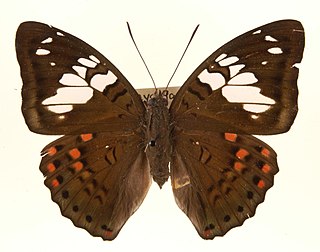
The morpho butterflies comprise many species of Neotropical butterfly under the genus Morpho. This genus includes more than 29 accepted species and 147 accepted subspecies, found mostly in South America, Mexico, and Central America. Morpho wingspans range from 7.5 cm (3.0 in) for M. rhodopteron to 20 cm (7.9 in) for M. hecuba, the imposing sunset morpho. The name morpho, meaning "changed" or "modified", is also an epithet. Blue morphos are severely threatened by the deforestation of tropical forests and habitat fragmentation. Humans provide a direct threat to this spectacular creature because their beauty attracts artists and collectors from all over the globe who wish to capture and display them. Aside from humans, birds like the jacamar and flycatcher are the adult butterfly’s natural predators.

Euthalia is a genus of brush-footed butterflies. They are commonly called barons or dukes.

Agrias is a genus of Neotropical charaxine nymphalid butterflies found in South and Central America.

Euthalia malaccana, or Fruhstorfer's baron, is a species of nymphalid butterfly found in the Indomalayan realm

Dichorragia nesimachus, the constable, is a species of nymphalid butterfly found in Asia. The genus was earlier considered to belong to the subfamily Cyrestinae and sometimes the Apaturinae, but is now considered as a sister of the genus Stibochiona in the subfamily Pseudergolinae. Several geographical forms with variations in colour are noted within the wide distribution range extending from India in the west to Japan in the east. In Vietnam, it is thought to show hill topping behaviour and is typically found in dense forest habitats. They may also be found mud puddling with other species.

Euthalia monina, the powdered baron or Malay baron, is a species of nymphalid butterfly. The species was first described by Frederic Moore in 1859.

Euthalia alpheda is an Indomalayan butterfly of the family Nymphalidae (Limenitidinae).

Euthalia adonia is a butterfly of the family Nymphalidae (Limenitidinae). It is found in the Indomalayan realm.

Euthalia anosia, the grey baron, is a butterfly of the family Nymphalidae (Limenitidinae). It is found in the Indomalayan realm.

Euthalia eriphylae is a butterfly of the family Nymphalidae (Limenitidinae). It is found in the Indomalayan realm.

Euthalia kanda is a butterfly of the family Nymphalidae (Limenitidinae). It is found in the Indomalayan realm.

Euthalia mahadeva is a butterfly of the family Nymphalidae (Limenitidinae). It is found in the Indomalayan realm.

Euthalia nara, the bronze duke, is a butterfly of the family Nymphalidae (Limenitidinae). It is found in the Indomalayan realm.

Euthalia sahadeva, the green duke, is a butterfly of the family Nymphalidae (Limenitidinae). It is found in the Indomalayan realm.

Euthalia tinna is a butterfly of the family Nymphalidae (Limenitidinae). It is found in the Indomalayan realm.

Euthalia whiteheadi is a butterfly of the family Nymphalidae (Limenitidinae). It is found in the Indomalayan realm.

Euthalia agnis is a butterfly of the family Nymphalidae (Limenitidinae). It is found in the Indomalayan realm.

Euthalia kardama is a butterfly of the family Nymphalidae (Limenitidinae). It is endemic to China. The species was first described by Frederic Moore in 1859.

















